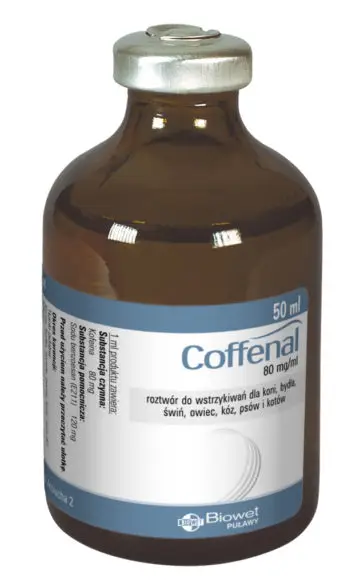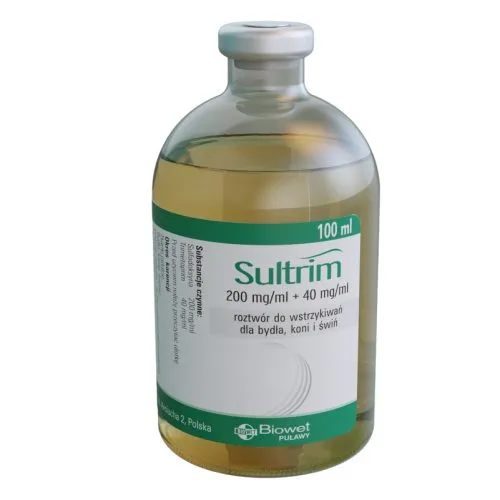Description
Polisulfamid (50 mg + 40 mg + 30 mg)/ml solution for injection for horses, cattle, pigs, sheep and dogs
Statement of the active substance(s) and other ingredient(s)
Each ml contains:
Active substances:
Sulfadimidine sodium – 50 mg
Sulfacetamide sodium – 40 mg
Sulfathiazole sodium – 30 mg
Excipient:
chlorocresol – 2 mg
Brown solution.
Target species
Horses, cattle, pigs, sheep, dogs.
Indications for use
Horses:
– respiratory infections caused by Staphylococcus spp., Streptococcus equi, Pasteurella multocida,
– gastrointestinal infections caused by Salmonella spp.,
– urinary infections caused by Streptococcus spp., Salmonella spp.,
– genital tract infections caused by Streptococcus spp., Escherichia coli, Klebsiella pneumoniae, Salmonella abortus equi,
– soft tissue infections caused by Staphylococcus spp., Streptococcus spp.,
Cattle:
– primary and secondary respiratory infections caused by Haemophilus somnus,Mannheimia haemolitica, Pasteurella multocida,
– enzootic pneumonia in calves (BRD) caused by Mannheimia haemolitica, Pasteurella multocida,
– colibacillosis in calves caused by Escherichia coli,
– calf diphtheria caused by sensitive Fusobacterium necrophorum,
– mastitis caused by Staphylococcus spp., Streptococcus spp., Escherichia coli,
Sheep:
– respiratory infections caused by Haemophilus somnus, Mannheimia haemolitica, Pasteurella multocida,
– enteritis caused by Escherichia coli,
Pigs:
– respiratory infections, including atrophic rhinitis in pigs caused by Streptococcus suis, Actinobacillus pleuropneumoniae, Actinobacillus suis, Bordatella bronchiseptica, Haemophilus parasuis, Pasteurella multocida,
– gastrointestinal infections caused by Escherichia coli, Salmonella choleraesuis,
– genitourinary infections: cystitis, urinary tract infection, MMA syndrome, postpartum infections caused by Staphylococcus spp., Streptococcus spp., Escherichia coli, Klebsiella spp.,
Dogs:
– laryngitis, bronchitis and pneumonia caused by Staphylococcus spp.,Streptococcus spp., Bordatella bronchiseptica, Klebsiella spp.,
– enteritis caused by Escherichia coli, Salmonella spp.,
– soft tissue infections caused by Staphylococcus spp., Streptococcus spp., Proteus spp., Nocardia spp.
Contraindications
Do not use in case of hypersensitivity to the active substances or to any of the excipients.
Do not use in animals with renal and hepatic failure, haematopoietic disorders, in dehydrated animals or in animals not taking water.
Do not use in pregnant and very young animals.
Special warnings
Special warnings:
Administration of excessively low doses of the product or excessively short therapy leads to development of microbial resistance to sulphonamides. For this reason, results of antimicrobial susceptibility testing must confirm the need of sulphonamide use.
During treatment, animals should be given plenty of water or provided with free access to water to prevent the development of crystalluria.
Sulphonamides are less efficient in purulent drainage and necrotic tissues.
Special precautions for safe use in the target species:
The veterinary medicinal product should be used based on results of microbial resistance for bacteria isolated from diseased animals. If this is impossible, administered treatment should be based on the local epidemiological information concerning susceptibility of isolated bacteria.
After administration of sulphonamides, animals may have difficulty passing urine, cloudy urine or haematuria, therefore they should be closely monitored during treatment.
Animals with hypersensitivity to sulphonamides may develop haematuria or apathy. In that event, discontinue administration of the product.
Dogs are particularly sensitive to sulphonamide action, large breed dogs in particular, in which administration of the product may elicit hypersensitivity reactions.
In case of intramuscular or subcutaneous administration, the product should be injected in a number of different sites.
In case of intravenous injection, the product should be warmed to body temperature and injected slowly.
Special precautions to be taken by the person administering the veterinary medicinal product to animals:
In case of accidental self-injection, seek medical advice immediately and show the package leaflet or the label to the physician.
Pregnancy:
Do not use during pregnancy.
Lactation:
The product can be used during the lactation period.
Interaction with other medicinal products and other forms of interaction:
Do not use simultaneously with methenamine and local anaesthetics belonging to the group of esters of para aminobenzoic acid.
Do not use simultaneously with acetylsalicylic acid.
Sulphonamides may transport drugs strongly binding with proteins, such as methotrexate, warfarin, phenylbutazone, thiazide diuretics, salicylates or probenecid. Therefore, concentrations of these drugs must be monitored. Using the product simultaneously with myelosuppressive drugs aggravates leucopoenia and thrombocytopenia. Using the product simultaneously with hepatotoxic drugs enhances their negative effect on the liver. Since the bacteriostatic effect of sulphonamides may interfere with the bactericidal effect of penicillin, it is not recommended to use them simultaneously.
Overdose:
Overdose leads to circulatory failure and induces signs of the central nervous system, such as ataxia, significant apathy. Coma may occur in instances of acute poisoning. In cattle, acute poisoning may promote signs of anaphylaxis, manifested in muscle tremor, muscle paralysis and visual impairment.
Overdosing sulphonamides may result in bone marrow damage, aplastic anaemia, granulocytopenia and thrombocytopenia. It may cause hepatitis, icterus, neuritis, degeneration of the spinal cord and peripheral nerves, stomatitis and keratitis.
Overdose in dogs may result in thymic hyperplasia or hypothyroidism.
In case of overdose, administer symptomatic treatment.
Major incompatibilities:
In the absence of compatibility studies, this veterinary medicinal product must not be mixed with other veterinary medicinal products.
Adverse events
Target species: Horses, cattle, pigs, sheep, dogs.
| Frequency unknown (cannot be determined on the basis of available data): | apathy1, fever1 collapse3, anaphylaxis1 difficulty passing urine, cloudy urine, hematuria1, crystalluria, renal tubular obstruction swelling at the injection site2, skin lesions1, hives (urticaria)1 ataxia3, muscle weakness3 arthritis1 haemolytic anemia1, agranulocytosis1 blindness3 gastrointestinal tract disorders 4 photosensitization |
1May occur in animals with hypersensitivity to sulphonamides.
2 May occur after intramuscular or subcutaneous administration.
3 May occur in case of rapid intravenous injection.
4 May occur as a result of bacteriostatic action of sulphonamides on gastrointestinal microbiota. This particularly applies to ruminants in which as a result of bacteriostasis of forestomach microbiota, synthesis of vitamin B may be impaired.
Reporting adverse events is important. It allows continuous safety monitoring of a veterinary medicinal product. If you notice any side effects, even those not already listed in this package leaflet, or you think that the medicine has not worked, please contact, in the first instance, your veterinarian. You can also report any adverse events to the marketing authorization holder using the contact details found at the end of this leaflet, or via your national reporting system: Department for Documentation Assessment and Pharmacovigilance of Veterinary Medicinal Products, Office for Registration of Medicinal Products, Medical Devices and Biocidal Products, Al. Jerozolimskie 181C, PL-02-222 Warszawa, Tel.: +48 22 49-21-687, Fax: +48 22 49-21-605, https://smz.ezdrowie.gov.pl.
Dosage for each target species, route(s) and method(s) of administration
The veterinary medicinal product should be administered intravenously, intramuscularly, intraperitoneally and subcutaneously.
Dosage: horses, cattle, pigs, sheep, dogs
Therapeutic dose for specific active substance:
sulfadimidine sodium 20-50 mg/kg b.w.
sulfacetamide sodium 16-40 mg/kg b.w.
sulfathiazole sodium 12-30 mg/kg b.w.
i.e. 48-120 mg of total sulphonamides / kg b.w.
Dosage in ml/ kg b.w.:
horses, cattle, pigs, sheep, dogs: 0.4-1.0 ml of the product/kg b.w.
The initial dose should be administered intravenously, which allows to develop high product concentration in the blood.
On consecutive days of treatment, use 2/3 to ½ of the initial dose.
Duration of therapy, with efficacy of the veterinary medicinal product confirmed by antimicrobial susceptibility testing, is 5 to 7 days.
Rapid intravenous injection causes toxic effect, producing clinical signs such as muscle weakness, ataxia, blindness and collapse.
Advice on correct administration
During treatment, animals should be given plenty of water or provided with free access to water to prevent the development of crystalluria.
The veterinary medicinal product administered intramuscularly or subcutaneously should be injected at different sites, whereas in case of intravenous injection, the product should be warmed to body temperature.
When administered intravenously, inject the product slowly.
Withdrawal period(s)
Cattle
Meat and offal – 10 days
Milk – 5 days
Sheep:
Meat and offal – 10 days
Do not use in sheep from which milk is intended for human consumption.
Pigs:
Meat and offal – 10 days
Dogs: not applicable
Do not use in horses from which meat and offal are intended for human consumption.
Horses treated at any time with the veterinary medicinal product must not be intended for slaughter for human consumption.
For use only in horses with signed declaration “not intended for slaughter for human consumption under applicable laws” in the horse passport.
Special storage precautions
Keep out of the sight and reach of children.
Store in a refrigerator (2°C – 8°C). Protect from light. Do not freeze.
Do not use this veterinary medicinal product after the expiry date which is stated on the label after EXP. The expiry date refers to the last day of that month.
Shelf life after first opening the immediate package: 28 days.
Special precautions for disposal
Medicines should not be disposed of via wastewater or household waste.
Use take-back schemes for the disposal of any unused veterinary medicinal product or waste materials derived thereof in accordance with local requirements and with any applicable national collection systems. These measures should help to protect the environment.
Ask your veterinary surgeon how to dispose of medicines no longer required.
Classification of veterinary medicinal products
Veterinary medicinal product subject to prescription
Marketing authorisation numbers and pack sizes
789/99
Pack size: 250ml
Date on which the package leaflet was last revised
26/09/2024
Detailed information on this veterinary medicinal product is available in the Union Product Database (https://medicines.health.europa.eu/veterinary).
Contact details
Marketing authorisation holder and manufacturer responsible for batch release:
Biowet Puławy Sp. z o.o.
Henryka Arciucha 2
24-100 Puławy
Poland
Tel./Fax: + 48 (81) 886 33 53, Tel.: + 48 (81) 888 91 00
e-mail: sekretariat@biowet.pl
Contact details to report suspected adverse events:
Biowet Puławy Sp. z o.o.
Henryka Arciucha 2
24-100 Puławy
Poland
Tel: + 48 (81) 888 91 33, + 48 509 750 444
e-mail: biowet@biowet.pl
SPC 2024-09-26
2025-03-21






